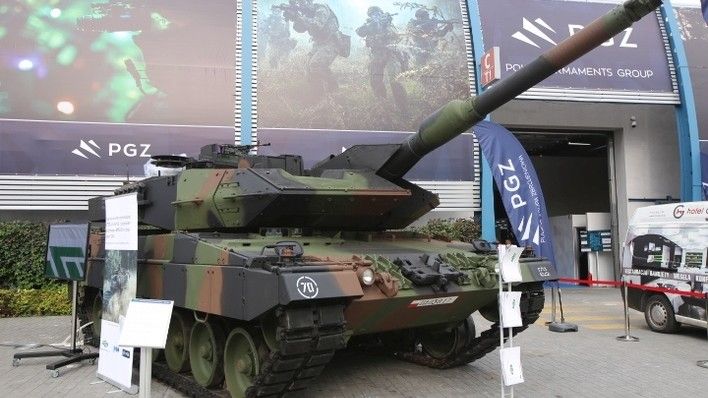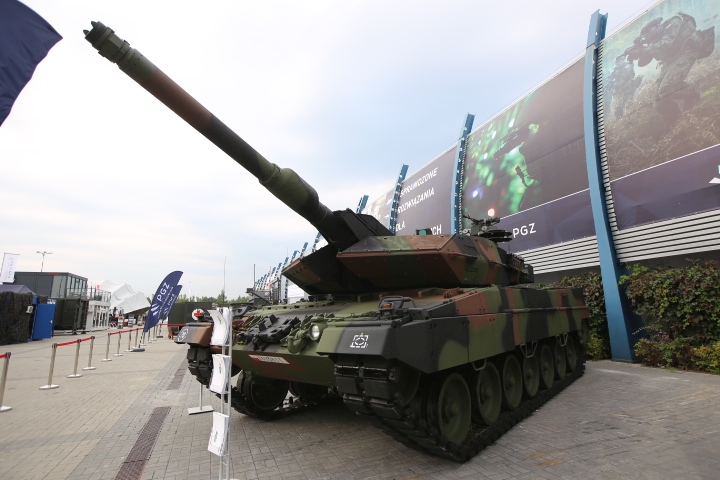MSPO 2018: Leopard 2A5 Main Battle Tank with Polish Thermal Imaging Systems and Armament

WZM S.A. facility has created an autonomous Leopard 2 main battle tank maintenance and servicing facility in Poznan. As a result of the above, WZM S.A. currently possesses a major amount of know-how within that domain. A modified Leopard 2A5 tank is being showcased by the company during the MSPO event in Kielce this year. The vehicle in question features a remote weapon station (remotely controlled armament module – as referred to in the Polish nomenclature) and thermal imaging systems developed at the companies that are a part of the PGZ Group. WZM is a member of the Polish Armaments Group as well.
According to the work division approved by PGZ back in 2015, within the framework of the Leopard project, WZM is acting as the leading entity when it comes to maintenance of the Leopard 2A5 main battle tanks per se, and of the power packs of all of the Polish Leopard tanks (2A4/2A5/2PL). The Poznan-based facility supports operational use of the tanks that are being gradually transferred from the 34th Armoured Cavalry Brigade based in Żagań to the 1st Armoured Brigade stationed in Wesoła.
At the moment Leopard 2A5 main battle tanks are the most modern platform of this class operated by the Polish Military. WZM, apart for carrying out maintenance and repairs, is also making steps towards modernizing the tanks by replacing the obsolete systems with their Polish counterparts. This is yet another step taken by WZM towards development and reinforcement of the facility’s potential. Introduction of even minor upgrades may significantly enhance the combat capability and operational features of the tanks. And this is the objective of works undertaken with regards to the tanks.
In 2016 WZM has developed an upgrade package for the Leopard’s communications suite. Last year, a spectacular premiere took place, involving a Leopard 2A5 tank wearing the “mobile camouflage” solution on its hull. The presentation was prepared in collaboration with the Lubawa S.A. company.
This year WZM showcases a Leopard 2A5 platform fitted with the ZSMU remote weapon station module and a modernized EMES-15 gunner’s sight also fitted with the KLW-1 Asteria thermal imaging system. ZSMU-1276A3B remote weapn station module delivered by ZM Tarnów replaces the 7.62 mm MG3 machine gun installed, by default, on the loader’s hatch. The new module makes it possible for the crew to fire the gun mounted on top of the turret while staying inside of the vehicle, with extended range at which the targets can be neutralized.

The remote gun station offers a wide range of movement for the .50-cal. machine gun embedded within it. The range of available angles is defined as follows: elevation: -5° to +50°; azimuth: n x 360°. The tank also features a fire control system coupled with an optoelectronic sensor and delivers higher targeting speeds (vertically and horizontally - at least ≤ 1 mrad/sec., vertically - maximally 1.5 rad/s (±10%) and horizontally - up to 2.8 rad/s (±10%)). All of the above makes it possible to effectively use the weaponry. Reloading within the ZSMU module may be completed electrically or manually (in case of faulty operation).
Utilizing the remote armament module also makes it possible to effectively act against secondary targets, such as the ATGM squads, light vehicles or certain types of UAVs. The crew is continuously protected when firing the weapons.
Modernization of the EMES-15 gunner’s sight carried out in collaboration with the PCO S.A. company is another modification implemented on the tank. It includes replacement of the 1st generation WBG sensor with the Asteria thermal imaging camera. The new camera features a III-gen cooled detector operated within the range between 8 µm and 12 µm. It also makes it possible to select the area of analysis for the imagery system. The detector has a resolution of 640×512 pixels and NETD coefficient of ≤30mK. Horizontal field of view is defined as follows: NFOV ≤ 3° WFOV ≤ 9°. The lens offers a minimum focusing distance of 50 meters. Asteria may be operated at temperatures between -30°C and +55°C, it is powered by the onboard power supply and also features a CCIR PAL video output.
This type of cameras has been designed with the Leopard 2A4PL upgrade programme in mind. KLW Asteria system is also being installed on the modified PT-91 tanks. Not only does introduction of cameras as such make it possible to enhance the combat capabilities of the vehicle (with the use of domestically available industrial potential), as it also makes the operated equipment standardized. This is important, as the older WBG cameras are being gradually withdrawn from use. This would make it more difficult to maintain their operational status. WZM also remains ready to integrate the Asteria systems within the PERI R17A2 commander’s panoramic sights. Other modifications are also, potentially, possible, including the aforesaid communications suite, reversing camera or a laser rangefinder. The modifications plan is interesting, as WZM would implement them without rendering the tanks unusable due to the ongoing modernization process. The offer may be implemented with the modifications being introduced during the periodic maintenance. This is an important argument for the user.
WZM maintains the Polish main battle tanks within the framework of an agreement with the 4th Regional Logistics Base in Wrocław. The Poznan facility has a task assigned to ensure recovery of operational status in case of the tanks maintained. The first vehicles already underwent relevant repairs, while the quality of delivered work is spoken of highly by the end user.
The representatives of the company estimate that the requirements of the military, when it comes to maintenance, would involve around 30 tanks per annum. This, however, concerns differing levels of maintenance, depending on the damage experienced by the given vehicle.
The facility also trains the soldiers, which makes it possible to carry out some part of field maintenance by the military units on their own. WZM’s representatives also emphasize the fact that the company has established a potential to independently carry out repairs and maintenance.